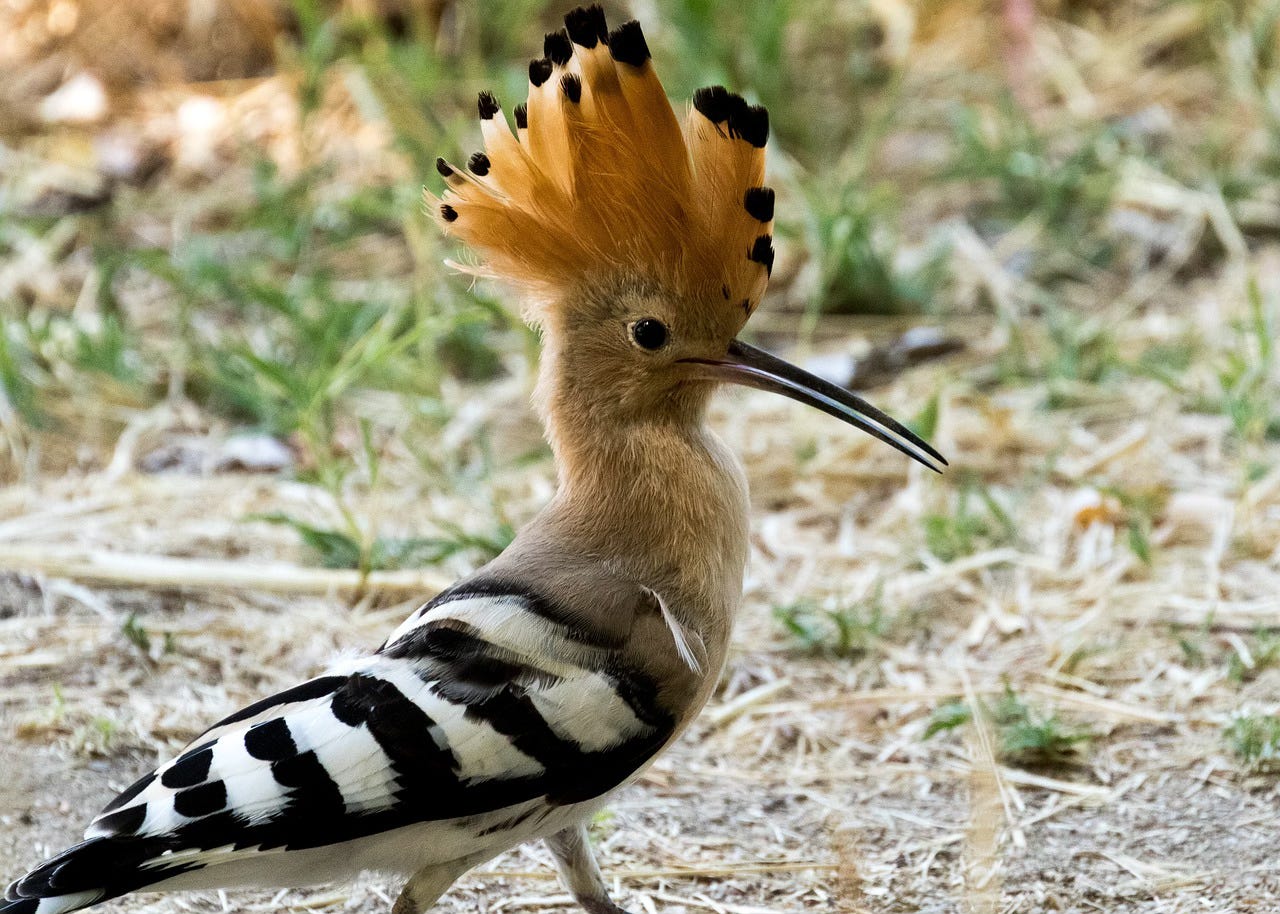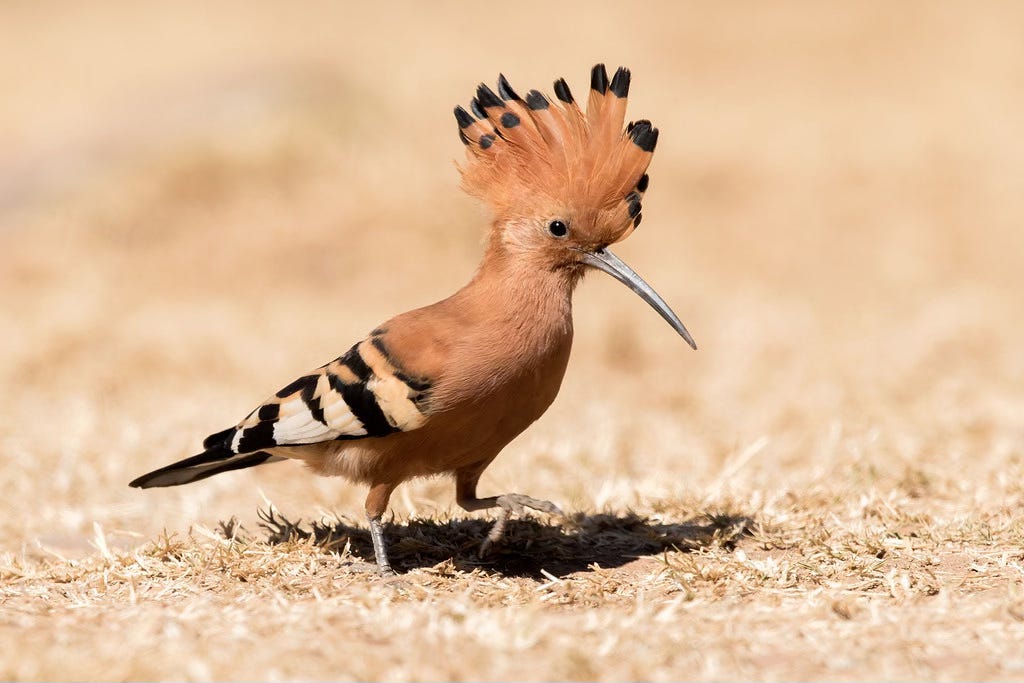Leaves from a Nature Notebook: The Hoopoe
The hoopoe has landed.
I looked out of the front window of our house in South West France this morning, and there was a hoopoe stumping about the paddock like an Aztec priest seeking sacrificial victims.
Even under the turquoise sky of a Charente spring, there is something inappropriately exotic about the migrant hoopoe – the pink-breasted, fan-crested, zebra-winged costume, the sharply decurved beak - as though it belongs to another place, another and more violent time. Which in a way it does; ancient cultures mythologized the bird endlessly. Ovid’s Metamorphoses is full of gruesome tales, but the most grotesque is King Tereus’ rape of his wife’s sister, Philomena, and the cutting out of her tongue.
Muted, Philomena weaves a tapestry depicting the violation; in sisterly revenge the queen cuts off her own baby’s head and feeds his body to Tereus in a stew. Enraged, Tereus chases after the sisters with a sword, intending to kill them both. To enable their escape, the gods turn the sisters into birds, the nightingale and the swallow. Tereus too is turned avian. He becomes the hoopoe; the bird’s crown symbolizes Tereus’ royalty, the beak his cruelty:
Fix’d on his head, the crested plumes appear
Long is his beak, and sharpen’d like a spear;
Thus arm’d, his looks his inward mind display.
Other cultures spin the Eurasian hoopoe more positively. In the twelfth-century epic The Conference of the Birds, the hoopoe is the wisest bird of all. Both the Qur’an and Jewish folklore associate the hoopoe with King Solomon, the wisest of all kings. A flock of hoopoes saves Solomon’s life by spreading their wings over him in an enormous canopy, protecting him from the burning sun, and the hoopoe was Solomon’s chosen messenger to the Queen of Sheba. (The hoopoe is the national bird of modern Israel.)
Photo Saturnino Miranda, Toledo, Spain
Still, the morbid tropes and archetypes of Graeco-Roman culture lurk and linger. I see a hoopoe, and I see Tereus. But, then I have seen male hoopoes fighting, the loser leaving the scene of their beaky mid-air joust less an eye; a hoopoe’s scimitar, gunmetal-grey beak is slender only in its deception. Plunged into the ground in pursuit of insects it can even open against the resistance of the earth.
For all its exoticism, the hoopoe is a surprisingly common bird of Europe, although England is its very northmost reach. (A pair bred in Leicestershire in 2023, but most hoopoes that cross the Channel do so as summer migrant ‘overshoots.) So, I fear that British ornithologists who describe the male bird’s call as ‘musical’, akin to the base note of gentle breath over a beer bottle top, do not know it, live with it. Truly, the call is a maddening metronymic beep at twenty times a minute, ‘hoopoe’ being etymological echo. If we are out and about in France and see a hoopoe flying past on its flashy black-and-white wings, my wife’s standard response is, ‘Hope it’s not coming to us.’ Three males’ beep-beep-beeping around the house on a sultry afternoon can grate on the nerves.
The relative ubiquity of the hoopoe owes something to its ability for repulsive deterrence of predators. The bird does chemical warfare rather well. If alarmed, the adult female releases a brown noisome fluid, akin to the stench of rotten meat (due particularly to the presence of dimethyl-sulphide) from a specialised gland under the tail.
Using her beak, the hoopoe hen also coats her feathers in the putrid goo, and if she has a newly laid clutch of eggs, she’ll smear these too. As biologists from the Universidad de Granada in Spain discovered in 2006, the stinky substance suppresses the feather-destroying bacterium, Bacillus licheniformi. The protective quality of the gloop extends to the eggs, where it performs a similar anti-bacterial role, ‘a living shield.’ The bio-chemical arsenal of the hoopoe is not yet finished. If the hen is away from the nest, which is usually a hole in a tree, the entire brood of chicks leans forwards in unison, cocks their tails and spurts reeking streams of excrement into the eye of the predator. The faecal torrents may reach 60cm.
Should the projectile guano fail, the chicks can hiss like snakes, and jab with their sharp bills. About half an average clutch of seven hoopoe chicks will make the flight to the wintering grounds in Africa. The bird is a brutal survivor, for all its flamboyant appearance.
I couldn’t resist a second picture of a Hoopoe - they’re rather photogenic.
Even so, the Eurasian hoopoe seems to be suffering a slight decline in numbers. In the Anthropocene it is not the order of a god on Mount Olympus, who can make or unmake, that threatens the bird, but the sales advice of an agri-chemical manufacturer like Bayer-Monsanto. The ‘icides’ of the gods were momentous things, parricide, matricide, infanticide; what we receive from the agri-chemical corps are pesticide, herbicide, fungicide, and molluscicide - the lot of them base but unfortunately effective exterminators of nature. The diet of Upupa epops -the Latin tag for the hoopoe being as onomatopoeic as the popular name - is almost exclusively carnivorous, with the large insects of agriculture, cockchafers and dung beetles, heading the diet sheet. So, the more the chemical deluge falls on agriculture, the less the hoopoes.
My sheep-nibbled, sheep-crotted, hedge-lined paddocks, the lot of them chemical free, are a natural haven for the hoopoe. They were always intended to be so. I may sometimes scream about the bird’s tortuous, repetitive oop-oop-oop but we should all be so lucky as to have the hoopoes for neighbours.




Wonderful, John.
I had no idea about the arsenal of deterrents that Hoopoes use - that was fascinating.
The aesthetic of the bird reminds me of a court jester, they are stunning birds to look at. In South Africa recently, I saw some African Hoopoes which have even richer ochre tones.
I am hoping that they eventually colonise the UK in a similar fashion to the plethora of herons and egret species that are starting to establish breeding strongholds.
Really enjoying your Substack and can't wait for your English natural history I saw you post about today.
Ah, but did you know that Upupa epops has its own louse which glories in the name Upupicola upupae? Wonderful.